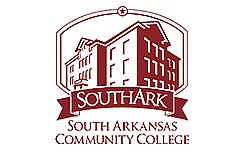The South Arkansas Community College Board of Trustees held a workshop on February 23, where they discussed the immediate and distant future of the institution.
The beginning of the workshop served as an orientation for board members, going over protocols, trustee manuals and responsibilities while serving on the board.
After the onboarding process, SouthArk president Bentley Wallace transitioned the board into a discussion around the school’s budget. He said the school’s revenue will take an immediate hit because of the lack of enrollment due to the ongoing COVID-19 pandemic.
The topic of enrollment then became one of the larger bucket items of the workshop.
Wallace referenced some national data on enrollment numbers over the last year when setting the stage for the discussion.
“The two-year public sector, that’s us, saw the sharpest decline in enrollment nationally with a 10% drop,” Wallace said. “A big chunk of the decline in higher education enrollment happened at the community college level.”
Wallace also brought the discussion of enrollment decline back to Arkansas.
“From 2011 to the Fall (semester) of 2020, we had 174,000 Arkansans attending college and this past Fall (semester), we were down to 147,000 students enrolled,” Wallace explained. “That is a significant decline in college-going rates here in Arkansas.
“What is this telling us?” one Trustee asked.
“On the two-year side, we have the natural occurrence of economy versus enrollment. We have the dwindling numbers of students entering. We have fewer and fewer students leaving high school; it is referred to as the impending enrollment cliff which was somewhat exacerbated by COVID,” Wallace replied.
“And in the last year, of course, we have the COVID effect, where people were just simply staying away from college… There is a combination of issues that is leading to this downward trajectory in enrollment,” he added.
“This is a little bit troubling if you were modeling this as a business,” Gary Griffis, Vice Chair of the Board, said.
“Yes it is,” Wallace said. “A large chunk of our funding comes from state but another large part of our revenue comes from tuition and fees and we’re having to adjust our budget accordingly. We’ve already done so this year and we’ll have to do it again to accommodate the reduced revenue from tuition and fees.”
Another aspect of the enrollment decline that schools like SouthArk are experiencing has to do with family planning, Wallace said.
“People are also not having kids at the same rate. People are concerned about the economy, so they’re not expanding their families,” Wallace said. “The number of kids in public and private schools are just not what they used to be.”
The decline in enrollment also extends across different ethnic and racial demographics, Wallace said.
“With race, you can see a little bit of disparity in our numbers. Hispanics are trending up in enrollment while Black, white, and others are trending down,” he said.
After the dialogue around enrollment and plans to further observe decline and potential solutions, Wallace transitioned the meeting to talk about the school’s goal to begin work on attracting more diverse candidates for hire around the college.
“We want to make sure all of our councils, committees and decision making structures are in line and in tune with diversity, equity, and inclusion,” he said.
“And diversity in hiring,” Wallace continued. “We are working on new models of outreach to underrepresented populations for when we do hire; we want to reflect our student body in our hiring decisions.”
To conclude the workshop, Wallace took a few questions and opened the floor for remarks and thanked everyone for actively participating in the discussion on ways the school can move forward with the ongoing challenges like the enrollment decline that was discussed.
